
How to grow poppy seeds
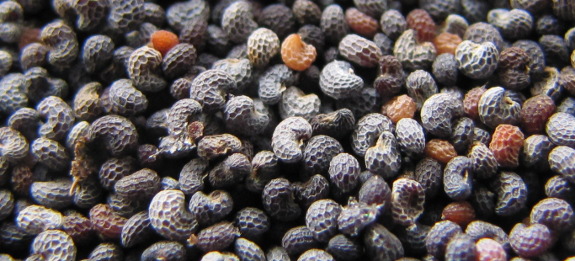
Although breadseed
poppies and opium poppies are in the same species and look very
similar, it's legal
to grow your own poppy seeds. Many websites will
tell you otherwise, though, so I was afraid to try my hand until I
found culinary poppy seeds being sold by a reputable seed company.
Growing poppies is
pretty simple, but I've learned a few tricks over the last couple of
years to increase yields. Unlike most ornamental poppies,
breadseed poppies aren't hardy enough to be seeded in the fall here in
zone 6, so you should instead scatter
the tiny seeds lightly on the soil surface in late February. If you live in a
warmer climate, you might get away with seeding in late autumn.
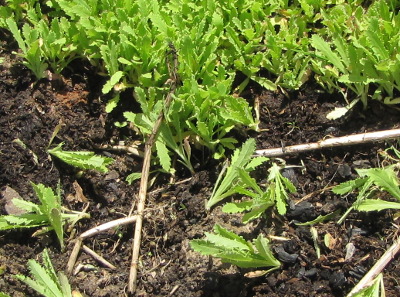 In 2010, I
sowed my seeds too far apart, so this year I planted more
heavily with the result that the seedlings formed a solid mass of green
across the bed by late April. That seems to have been overkill
--- fewer poppy seeds came up on a different bed, and these better
spaced seedlings resulted in much larger pods. I suspect that the
optimal distance between plants would be about four inches in a highly productive,
no-till garden, although extension service websites suggest 6 to 8 inch
spacing in a more conventional garden. If you're going to
overplant and thin, remove the extra seedlings by March or early April
--- I thinned later than I should have in the photo above.
In 2010, I
sowed my seeds too far apart, so this year I planted more
heavily with the result that the seedlings formed a solid mass of green
across the bed by late April. That seems to have been overkill
--- fewer poppy seeds came up on a different bed, and these better
spaced seedlings resulted in much larger pods. I suspect that the
optimal distance between plants would be about four inches in a highly productive,
no-till garden, although extension service websites suggest 6 to 8 inch
spacing in a more conventional garden. If you're going to
overplant and thin, remove the extra seedlings by March or early April
--- I thinned later than I should have in the photo above.
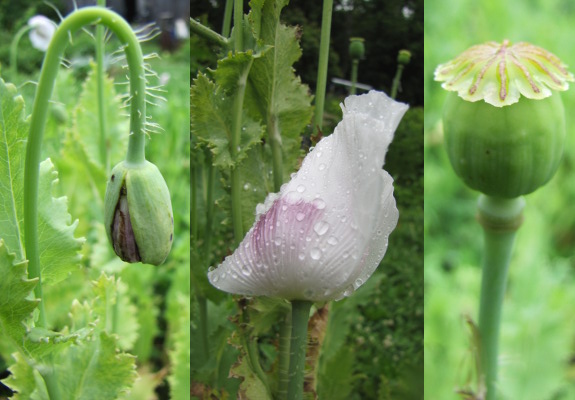
Your breadseed poppies
will be in full bloom in June, and your honeybees will love them.
Besides keeping the plants weeded, you don't have to do anything now
until the pods bulk up and then turn brown. At that point, snip off
the seed heads and bring them inside to dry.
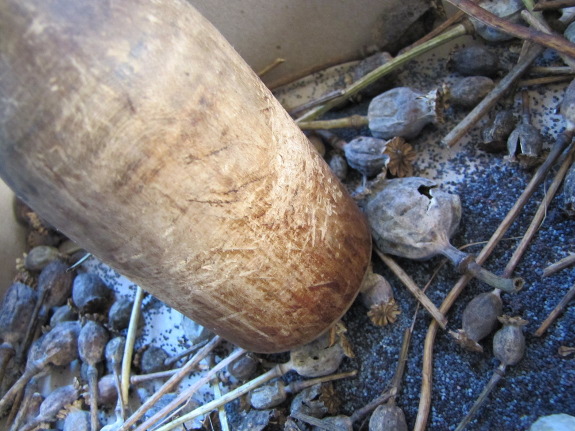
Once the poppy heads are
entirely dry, tiny holes near the top of the pod will open, so it's
technically feasible to shake mature pods in a paper bag until all of
the seeds fall out. In practice, though, it's much more efficient
to pound the
pods to crush them, tear the heads open a little more with your
fingers, and then shake out the seeds from one pod at a time. This really doesn't
take very long if you've just grown a small patch of poppies.
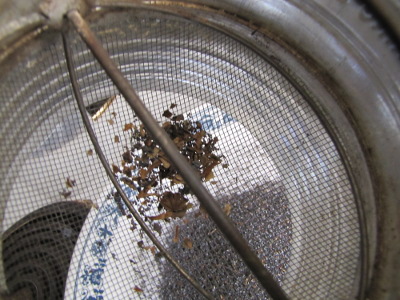 Poppy seeds are too small to
winnow easily in front of a fan, but you can remove
nearly all of the bits of chaff by sending the seeds through a sifter. Let the seeds dry a
bit more in an open container, then seal them away for winter
treats. I've discovered that if I paint raw egg on the top of
homemade buns before their last rise, sprinkle on breadseed poppies,
then mash the seeds into the dough with the palm of my hand, nearly all
of the precious seeds stay in place and the plain old bread turns into
a treat. I figure this year's quarter cup harvest will last all
winter.
Poppy seeds are too small to
winnow easily in front of a fan, but you can remove
nearly all of the bits of chaff by sending the seeds through a sifter. Let the seeds dry a
bit more in an open container, then seal them away for winter
treats. I've discovered that if I paint raw egg on the top of
homemade buns before their last rise, sprinkle on breadseed poppies,
then mash the seeds into the dough with the palm of my hand, nearly all
of the precious seeds stay in place and the plain old bread turns into
a treat. I figure this year's quarter cup harvest will last all
winter.
Want more in-depth information? Browse through our books.
Or explore more posts by date or by subject.
About us: Anna Hess and Mark Hamilton spent over a decade living self-sufficiently in the mountains of Virginia before moving north to start over from scratch in the foothills of Ohio. They've experimented with permaculture, no-till gardening, trailersteading, home-based microbusinesses and much more, writing about their adventures in both blogs and books.
Want to be notified when new comments are posted on this page? Click on the RSS button after you add a comment to subscribe to the comment feed, or simply check the box beside "email replies to me" while writing your comment.
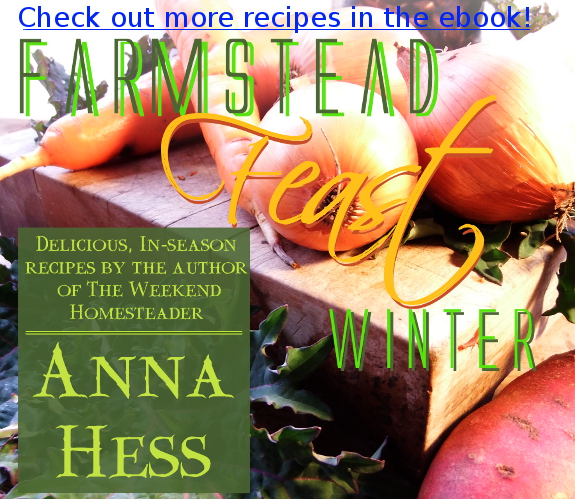

Thanks Anna! My breadseed poppies were a complete no-show this spring, but I will try again thanks to your encouragement and tips. I love it when you geek out with charts (like in the recent seed saving post), and I love your blog. What do you like to bake w/ your seeds? Thanks, Paula
Breadseed poppies do seem to take a bit more care than some other crops, but I think that if you stick with it, you'll get them to grow.
I mostly just put the poppy seeds on top of buns, but I also like to make lemon poppyseed muffins. Delicious!
Thanks for your kind words! I always wonder a bit if my extra-geeky posts are skipped over or enjoyed.
i really like yr website.
ps. theyre legal to grow but they are pretty much exactly the same.
Thanks for your kind words, Edi!
I can't quite figure out whether opium poppies and breadseed poppies are really "exactly the same" or not. Sure, they're in the same species, but varieties can be extremely different. I have read that there are several different varieties of breadseed poppies with different culinary and horticultural traits, so presumably there are also varieties of the species that have been bred for higher opium content. Hard to say, though!
Maria --- If you want to eat the seeds, you have to let the pods mature fully on the plant. It can help to tie them up so they don't flop down. The plant is pouring energy into building those seeds even though the plants look like a mess.
This species of poppy is an annual, so once the seeds are ripe, you can pull the whole thing out --- it should be dead or nearly dead by then anyway. You'll need to plant from seed again next year. Good luck!